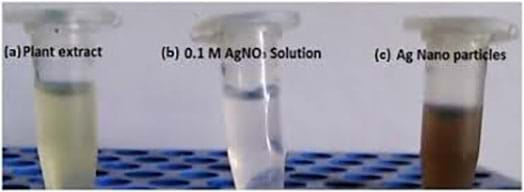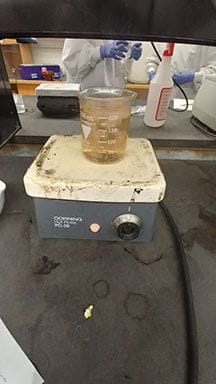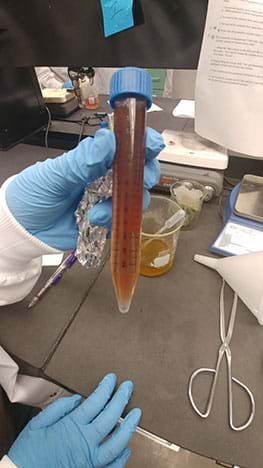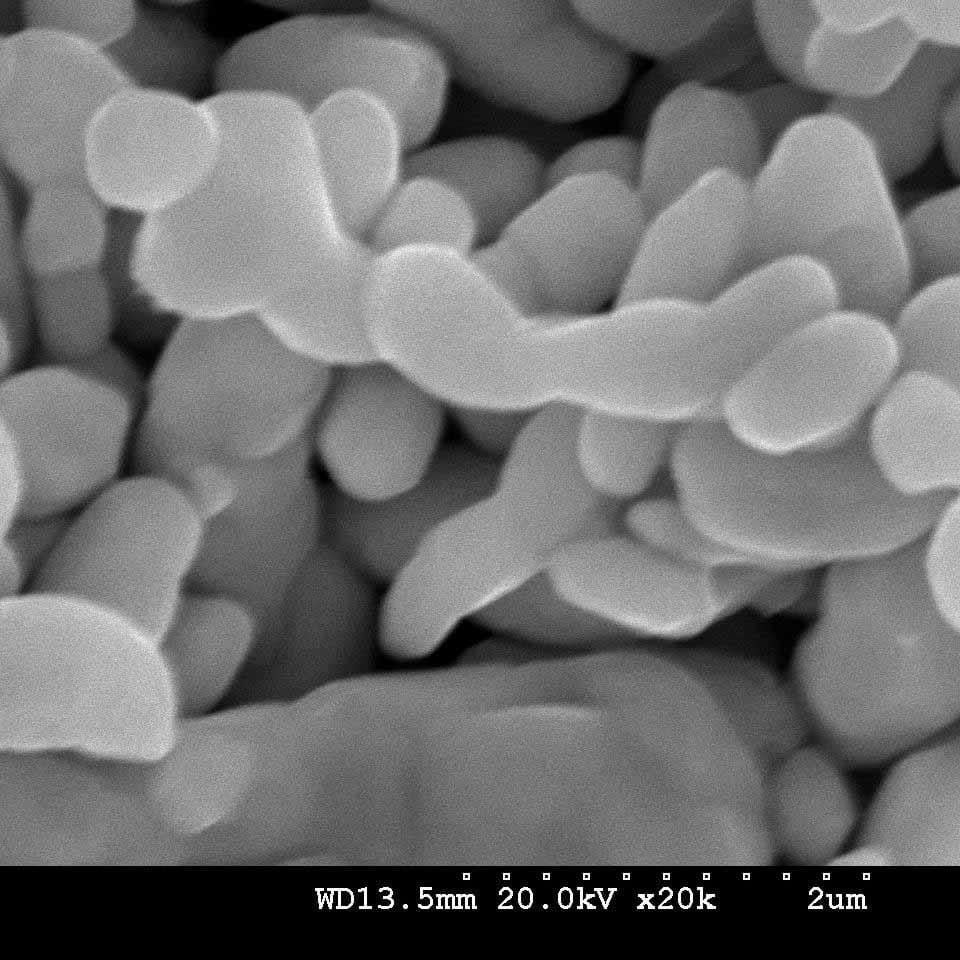Quick Look

Summary
Engineering silver nanoparticles for use in water filters has shown promising results in keeping water free of disinfection byproducts that arise after chlorination. In this activity, the students do individual research to learn about nanotechnology and silver nanoparticles, and how silver nanoparticles can be used in water treatment. Students choose a plant of their choice (from home, school, or from the teacher) to use as an agent to reduce silver nitrate into silver nanoparticles. They retest with a different plant or change the procedure to see if they can improve their chances at engineering nanoparticles.Engineering Connection
Students use principles of reduction reactions to engineer a plant extract that can effectively reduce silver nitrate into silver nanoparticles. Students identify how disinfection byproducts are a problem in water treatment and how environmental engineers can use silver nanoparticles to fix these problems. They test a plant of their choice and evaluate how well their plant works at making silver nanoparticles, and then they iterate on their testing using different parameters to see if they can achieve a better result. Like engineers iterating their designs, students make improvements in their design proposals in order to create the most efficient process.
Learning Objectives
After this activity, students should be able to:
- Discuss how nanotechnology and silver nanoparticles can be used in water treatment.
- Explain the current process for creating silver nanoparticles and issues with cost of use of energy to make them.
- Describe how plants can be used as a reducing agent when added to silver nitrate to make silver nanoparticles.
- Explain the results of their experiment and make recommendations for what plant(s) to use to make silver nanoparticles.
Educational Standards
Each TeachEngineering lesson or activity is correlated to one or more K-12 science,
technology, engineering or math (STEM) educational standards.
All 100,000+ K-12 STEM standards covered in TeachEngineering are collected, maintained and packaged by the Achievement Standards Network (ASN),
a project of D2L (www.achievementstandards.org).
In the ASN, standards are hierarchically structured: first by source; e.g., by state; within source by type; e.g., science or mathematics;
within type by subtype, then by grade, etc.
Each TeachEngineering lesson or activity is correlated to one or more K-12 science, technology, engineering or math (STEM) educational standards.
All 100,000+ K-12 STEM standards covered in TeachEngineering are collected, maintained and packaged by the Achievement Standards Network (ASN), a project of D2L (www.achievementstandards.org).
In the ASN, standards are hierarchically structured: first by source; e.g., by state; within source by type; e.g., science or mathematics; within type by subtype, then by grade, etc.
NGSS: Next Generation Science Standards - Science
| NGSS Performance Expectation | ||
|---|---|---|
|
HS-ETS1-2. Design a solution to a complex real-world problem by breaking it down into smaller, more manageable problems that can be solved through engineering. (Grades 9 - 12) Do you agree with this alignment? |
||
| Click to view other curriculum aligned to this Performance Expectation | ||
| This activity focuses on the following Three Dimensional Learning aspects of NGSS: | ||
| Science & Engineering Practices | Disciplinary Core Ideas | Crosscutting Concepts |
| Design a solution to a complex real-world problem, based on scientific knowledge, student-generated sources of evidence, prioritized criteria, and tradeoff considerations. Alignment agreement: | Criteria may need to be broken down into simpler ones that can be approached systematically, and decisions about the priority of certain criteria over others (trade-offs) may be needed. Alignment agreement: | |
| NGSS Performance Expectation | ||
|---|---|---|
|
HS-PS1-2. Construct and revise an explanation for the outcome of a simple chemical reaction based on the outermost electron states of atoms, trends in the periodic table, and knowledge of the patterns of chemical properties. (Grades 9 - 12) Do you agree with this alignment? |
||
| Click to view other curriculum aligned to this Performance Expectation | ||
| This activity focuses on the following Three Dimensional Learning aspects of NGSS: | ||
| Science & Engineering Practices | Disciplinary Core Ideas | Crosscutting Concepts |
| Construct and revise an explanation based on valid and reliable evidence obtained from a variety of sources (including students' own investigations, models, theories, simulations, peer review) and the assumption that theories and laws that describe the natural world operate today as they did in the past and will continue to do so in the future. Alignment agreement: | The periodic table orders elements horizontally by the number of protons in the atom's nucleus and places those with similar chemical properties in columns. The repeating patterns of this table reflect patterns of outer electron states. Alignment agreement: The fact that atoms are conserved, together with knowledge of the chemical properties of the elements involved, can be used to describe and predict chemical reactions.Alignment agreement: | Different patterns may be observed at each of the scales at which a system is studied and can provide evidence for causality in explanations of phenomena. Alignment agreement: |
Common Core State Standards - English
-
Cite specific textual evidence to support analysis of science and technical texts, attending to the precise details of explanations or descriptions.
(Grades
9 -
10)
More Details
Do you agree with this alignment?
International Technology and Engineering Educators Association - Technology
-
Students will develop an understanding of the attributes of design.
(Grades
K -
12)
More Details
Do you agree with this alignment?
-
Students will develop an understanding of engineering design.
(Grades
K -
12)
More Details
Do you agree with this alignment?
-
Students will develop an understanding of the relationships among technologies and the connections between technology and other fields of study.
(Grades
K -
12)
More Details
Do you agree with this alignment?
-
Students will develop an understanding of the effects of technology on the environment.
(Grades
K -
12)
More Details
Do you agree with this alignment?
-
Students will develop an understanding of the role of troubleshooting, research and development, invention and innovation, and experimentation in problem solving.
(Grades
K -
12)
More Details
Do you agree with this alignment?
-
Critue whether existing and proposed technologies use resources sustainably.
(Grades
9 -
12)
More Details
Do you agree with this alignment?
-
Optimize a design by addressing desired qualities within criteria and constraints.
(Grades
9 -
12)
More Details
Do you agree with this alignment?
State Standards
Texas - Science
-
develop and use general rules regarding solubility through investigations with aqueous solutions;
(Grades
10 -
12)
More Details
Do you agree with this alignment?
-
organize, analyze, evaluate, make inferences, and predict trends from data; and
(Grades
10 -
12)
More Details
Do you agree with this alignment?
Materials List
Each group needs:
- whiteboards (one per pair of students in group of four)
- dry erase markers and erasers
- plant material for students to test (See Before the Activity below for suggestions)
- 15 m conical tube
- mortar and pestle
- 400 ml beaker with 200 ml of water
- funnel
- filter papers
- hot plate
- 10 ml of 0.1 M AgNO3 (silver nitrate) from teacher’s stock solution; extract with a pipette
- scale
- gloves
- goggles
- razor blade
- internet access via laptop or cellular device
- Engineering Silver Nanoparticles Student Worksheet
Teacher materials to make 0.1 M silver nitrate:
- scale
- weigh boat or weigh paper
- scoopula
- 250 ml brown bottle with lid
- distilled water
- label tape
- gloves
- goggles
To share with the entire class:
- Engineering Silver Nanoparticles PowerPoint Presentation
- 200 ml of 0.1 M of AgNO3 stock solution
- gallon Ziploc bags with plant materials
Worksheets and Attachments
Visit [www.teachengineering.org/activities/view/rice2-2370-engineering-silver-nanoparticles] to print or download.Pre-Req Knowledge
Students should know the basic structure of an atom, including the concept that electrons are found in orbitals surrounding the nucleus. The students should know that an ion is an atom with an unequal amount of protons and electrons.
Introduction/Motivation
Silver (Ag) is an element that has many practical applications. Silver is used to make silverware, mint coins and currency, or fashioned into jewelry. Its versatility means we can also use it to help us with many of our problems. Scientists and engineers found that nanoparticles derived from silver can be used as a type of cleaning agent, from used gym shoes water sanitation. Silver nanoparticles have antimicrobial properties that can kill small microbes. They can be attached to water filters and columns to kill microbes and help remove other harmful products from the water, such byproducts of disinfection.
There are two main methods used to synthesize silver nanoparticles. Engineers can use a “top-down” approach that requires mechanical grinding of bulk silver metals or they can use a “bottoms-up” method which includes using chemical reactions. Both methods can be expensive, and the materials used to make silver nanoparticles are toxic and hazardous. Plants, however, contain unique reducing agents that can synthesize silver nanoparticles without creating toxic waste. Plant extracts can reduce silver ions because of the combination of biomolecules they contain, such as proteins, enzymes, amino acids, tannins, and many more. Our task as environmental engineers will be to determine which plant may effectively reduce silver and produce the most silver nanoparticles, so we may use them in a filters design for a water treatment facility.
Procedure
Background
Metallic nanoparticles are used in engineering and medical fields due to their unique properties and size. Silver nanoparticles have been receiving special interest in the medical field for their antimicrobial properties, and in the environmental field for their ability to remove disinfection byproducts from water. They can also prevent biofouling on water filter membranes. Biofouling can occur when there is a buildup of microorganisms on a filter that is used to clean water. Silver nanoparticles are produced two ways: top to bottom and bottom to top. In the top to bottom method, nanoparticles are produced using evaporation-condensation in a tube furnace at atmospheric pressure. This process requires a lot of space for equipment, energy to heat the substances up, and time to occur. The bottom to top process produces nanoparticles chemically by using reducing agents. Reduction is a chemical process by which one of the atoms involved gains electrons from the other. Plant extracts are used as reducing agents because they gain an electron from the silver ion to make it a silver nanoparticle with no charge. In the reaction, you can see that silver initially has a charge of +1, and afterwards has no charge.
Ag+ (aq) -----> Ag (s)
One of the most common reducing agents is sodium borohydride (NaBH4). The full chemical reaction is shown below:
AgNO3(aq) + NaBH4(aq) → Ag(s) + 1/2H2(g) + 1/2B2H6(g) + NaNO3(aq)
Unfortunately, this process is toxic and not environmentally friendly. As a solution, scientists are looking to plants. Plants contain natural reducing agents that turn silver ions (Ag+) to silver nanoparticles (Ag0). Biomass and microorganisms are also being engineered as a green way to synthesize silver nanoparticles. The silver nanoparticles that are produced can be added to a water filter or granulated activated carbon in a water column to help remove disinfection byproducts and reduce biofouling.
Before the Activity
- Teacher needs to prepare 200 ml of 0.1 M of AgNO3 solution that the whole class will use.
- Using a scale, measure out 3.4 g of AgNO3 by using a scoopula to transfer the AgNO3 from the stock bottle to a weigh boat or weigh paper on the scale.
- Add 100 ml of distilled water to a brown 250 ml bottle and add the 3.4 g of AgNO3.
- Stir the solution and then add more distilled water until you reach the 250 mL mark.
- Mix the solution and label the bottle “0.1 M of AgNO3 “ Note: Silver nitrate is light sensitive and should be stored in a brown bottle. Gloves and goggles should be worn when preparing the solution because silver nitrate can stain skin.
- Collect a gallon size zip lock bag of different plants for students to use in the lab.
- Some suggestions for plants to use: ficus (leaves), banana (peel), aloe vera, orange (peel), lemongrass (leaves), tea extract, lotus (leaves), onion (leaves), and grapes (fruit).
- Set materials on 8 lab tables for student groups of four (maximum).
With the Students
- Introduce the activity using the Engineering Silver Nanoparticles PowerPoint Presentation. Have students brainstorm the different uses of silver nanoparticles on their whiteboard with a partner. Students share what they came up with for the class.
- Ask students: “Have you ever thought of using silver to clean water?”
- (Slide 3) Use the “Nanosilver and Biofouling” video in the presentation to introduce how silver nanoparticles are being used to clean water.
- (Slide 4) Have students do individual research using the internet on laptops or cellular devices to get some background information on nanotechnology, and silver nanoparticles. You may split this part up per pair of students and have them share what they learned with their partner. Students will put their findings from their research on the Engineering Silver Nanoparticles Student Worksheet.
- (Slides 5-9) Use the PowerPoint to help explain to students that the traditional way of producing silver nanoparticles requires using harsh chemicals that are bad for our environment. Explain that plants have chemicals in them that can reduce the silver to a nanoparticle form.
- Have students use the instructions on their Engineering Silver Nanoparticles Student Worksheet to make their plant extract (See Figure 1 for set up).
- Instruct students to analyze their solution to see if they created silver nanoparticles (See Figure 2 for an example of silver nanoparticle formation).
- The solution should turn a light yellow to brown color if silver nanoparticles formed. Students record their qualitative observations in the Engineering Silver Nanoparticles Student Worksheet. The browner the solution, the less likely they made small silver nanoparticles. As groups complete their analyses, display Slide 11 of the PowerPoint.
- (Slide 11) Have students fill out the “Class Results” table and whether they had a color change or not. Have each group talk about their experience in making the plant extract and silver nanoparticles. Have them share their results and any possible errors. The less color change, the smaller the nanoparticles formed. The greater the color change, the larger the nanoparticles. Smaller silver nanoparticles are ideal because they take up less space and will allow for more silver nanoparticles in water filters and columns. If students did not clean their plant well enough before making the extract, silver precipitate may form in their solution.
- (Slide 12) Students can retest their plants by changing the amount of plant material used to make the extract, or changing their plant to another plant (or plants) to see if they get better results.
- (Slide 13) Allow students to make a decision of what plant (or plants) they would use to make silver nanoparticles to add to the water filters. At the end of the activity, tell students write a letter to a water plant foreman with their recommendation for how to improve their filter using data from their experiment and information from their research to justify their recommendation.


Vocabulary/Definitions
nanotechnology: Technology that deals with dimensions and tolerances of less than 100 nanometers, such as the manipulation of individual atoms and molecules.
reducing agent : A substance that tends to bring about reduction by being oxidized and losing electrons.
reduction: Chemical reaction involving the gaining of electrons by one of the atoms involved in the reaction; refers to the element that accepts electrons, as the oxidation state of the element that gains electrons is lowered.
silver nanoparticles: Nanoparticles of silver of between 1 nm and 100 nm in size.
Assessment
Pre-Activity Assessment
What are the uses of silver? Ask the students to write down the different things they know that silver is used for. For example, silverware, jewelry, coins, etc.
Activity Embedded Assessment
Student Worksheet: Have students work through the Engineering Silver Nanoparticles Student Worksheet.
- Explain where all materials are located in the lab area and begin with identifying the materials needed for the experiment, safety materials, safety hazards and proper procedures for the lab protocol.
- Explain the purpose of the experiment and have students choose which plant or plants they want to test.
- Which plant will produce the most silver nanoparticles?
- Students will write down qualitative and quantitative data on the Engineering Silver Nanoparticles Student Worksheet.
- Have students share their results with the class and fill out the post-lab questions on the Engineering Silver Nanoparticles Student Worksheet. It is important to reiterate that failures are okay and that there is always something that can be learned from a failure.
- Have students create a list of “What Ifs…” and come up with a list of uses for their silver nanoparticles.
Post-Activity Assessment
Letter to Water Plant: Students write a letter to a water plant foreman recommending the use of silver nanoparticles and why they should be used on the water filter and columns. Students describe the process of making silver nanoparticles from plants and make a suggestion for the best plant(s) to use.
Investigating Questions
How can silver nanoparticles clean water? (Answer: Silver nanoparticles have antimicrobial properties. When silver is chemically coated onto the surface of a membrane filter, the nanoparticles kill and prevent the growth of microbes. Silver-coated filters last longer and produce more clean water.)
How can plants be used to make silver nanoparticles? (Answer: Plants can act as reducing agents in the reaction that turns silver ions (Ag+) to silver nanoparticles (Ag0). Plant extract replaces common reducing agents like sodium borohydride (NaBH4), which leads to a more environmentally-friendly reaction with less harmful byproducts.)
Safety Issues
Students should wear goggles and globes during the lab experiment. Students must use caution if they need to use a razor blade to slice up their plant.
Troubleshooting Tips
A precipitate may form as a byproduct once students add the plant extract. This may occur if the plant is not cleaned with distilled water beforehand.
Activity Scaling
- For higher grades, have students make suggestions for how they could improve their silver nanoparticle production with plants.
Subscribe
Get the inside scoop on all things TeachEngineering such as new site features, curriculum updates, video releases, and more by signing up for our newsletter!More Curriculum Like This

Students test nanoparticle solutions to determine the best nanoparticle to remove organic compounds from water. They test for the efficiency of photocatalytic nanoparticles to sanitize (or bleach) water by exposing a solution sample with newly made water sanitation filters under UV light (sunlight) ...

Students explore how to create silver nanoparticles and use empirical data to make observations about their creation. Students learn about oxidation, reduction, and redox reactions in order to create a process for growing silver nanoparticles in the laboratory in a more efficient manner.
References
Ahmed, S., Ahmed, M., Lal Swami, B., & Ikram, S. (2015, March 09). A review on plants extract mediated synthesis of silver nanoparticles for antimicrobial applications: A green expertise. Retrieved July 21, 2018, from https://www.sciencedirect.com/science/article/pii/S2090123215000314
Copyright
© 2019 by Regents of the University of Colorado; original © 2018 Rice UniversityContributors
Taylor MillerSupporting Program
Engineering Research Center for Nanotechnology Enabled Water Treatment Systems (NEWT) RET, Rice UniversityAcknowledgements
This curriculum was based upon work supported by the National Science Foundation under Rice University Engineering Research Center for Nanotechnology Enabled Water Treatment Systems (NEWT) RET grant no.1449500. Any opinions, findings, and conclusions or recommendations expressed in this material are those of the authors and do not necessarily reflect the views of the National Science Foundation.
Special thanks to Christina Crawford.
Last modified: August 6, 2020









User Comments & Tips